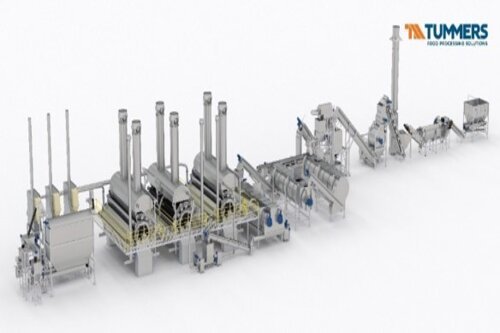Potato Chips Making Machine
The Potato Chips Making Machine is an automated machine that is simple to use and saves personnel. The Potato Chips Making machine is easy to clean and satisfies hygiene requirements.
The entire process of Washing, Peeling, Slicing, Washing, De-watering, Frying, Seasoning, and other procedures to produce tasty potato chips using fresh potatoes as raw materials. It is one of the most popular snack foods in the world, with a crispy taste and a variety of flavours and packaging suited for people of all ages.
Potatoes have been utilized as a food source since prehistoric times. Today, only a few fast foods are available in the market that do not contain potatoes in any of their forms, such as fries or chips. Because of this, potato consumption has skyrocketed.
It has high fibre content and a sweet flavour. Simultaneously, Potato Chips are heavy in fat and calories, putting you in danger of gaining weight. obesity and weight gain Vitamins and minerals are few in chips. It is made up of salt is bad for your heart since it raises blood pressure. The manufacture of potato chips begins with the storage of potatoes. potato cooked at a low temperature until it is ready to be packaged.
Chips are often regarded as the most popular and pleasurable snack of all time. Old and young alike enjoy the Crisp, Sufficiently cooked, and flavorful thin pieces. The chip manufacturing business is fairly broad, with global names like Lays, Haldiram, Balaji, and others having established themselves throughout the years, as well as local firms having a substantial portion of the market.
Starting a Chips-making business necessitates the installation of precision-engineered equipment, batch and continuous-type gear for all stages of chip processing, including washing, peeling, slicing, frying, flavouring, and packaging.
Fresh potatoes are used as raw materials in the Potato Chips Making Machine Production Line, and the entire process of Washing, Peeling, Slicing, Washing, De-watering, Frying, Seasoning, and other steps are followed to produce delicious potato chips, which are one of the world's most popular snack foods. It's simple to use, saving time and money, and it's constructed of stainless steel, making it easy to clean. It also fulfils hygienic requirements thanks to an automated and reliable production process.
Raw material for Potato Chips Making Machine
To turn raw potatoes into chips, they must go through a series of steps. To manufacture crispy chips, it must tolerate high temperatures in furnace oil. If the chips are not able to endure the high temperature of the oil (195° C), they may turn crimson.
To avoid this problem, raw potatoes are kept at low temperatures, which boosts their heat-absorbing ability. Regular kitchen potatoes do not require this attribute since they do not require such a high temperature. As a result, the potato chip production machine's initial stage is completed.
The skin of the potato must be removed since it contains dust, sand particles, and other contaminants and should be discarded. Manual peeling can be used to remove the skin, although it is difficult to execute on a wide scale. Automatic peeling equipment is necessary to carry out the procedure on a wide scale.
It has a silicon carbide-covered plate that spins on a shaft connected to the motor. The plate's surface is wavy, so the potatoes in the upper section slide downward, and the potatoes in the lower portion move higher when the plate rotates. The skin erodes when it comes into touch with the silicon carbide plate, and the skin is removed by a continual water supply.
When the potatoes arrive at the facility, they are inspected and tested to ensure that they are of good quality. A half-dozen or so buckets are filled at random. Some have holes drilled in their cores to allow for tracking during the cooking process. Green edges and blemishes are checked on the potatoes. If the weight of the mound of damaged potatoes exceeds a company's established allowance, the entire truckload may be rejected.
The potatoes are transported to various stages of processing through a conveyor belt. To reduce damage to a minimum, the conveyor belts are propelled by moderate vibrations.
The potatoes are fed into a vertical helical screw conveyer, which enables stones to fall to the bottom and pushes the potatoes up to the automated peeling machine through a conveyer belt. The potatoes are rinsed in cold water after they have been peeled.
The potatoes are sliced into paper-thin slices between 0.066 and 0.072 inches thick using a rotating impaler presser. Regular chips are made using straight blades, whereas ridged potato chips are made with rippled blades. The slices are washed again in cold water to eliminate the starch that is produced when the potatoes are sliced.
If the potatoes require chemical treatment to improve their colour, this is done now. The potato slices are submerged in a solution with pH, hardness, and mineral content regulated. As the slices run into 40-75 ft troughs loaded with oil, they pass through air jets that eliminate any extra water.
The temperature of the oil is controlled between 350 and 375 degrees Fahrenheit. The slices are gently pushed along by paddles. Salt is sprinkled on the slices as they drop from receptacles above the trough at a rate of around 1.75 pounds of salt for every 100 pounds of chips.
Flavored potato chips are passed through a drum with the necessary powdered spices. A wire mesh belt pushes the heated chips out of the trough's end. Excess oil is drained from the chips as they go over the mesh conveyor belt, and the chips begin to cool. They next pass through an optical sorter, which detects any burned slices and eliminates them with air puffs.
The chips are sent to a packing machine. A metal detector checks the chips once again for any foreign materials, such as metal bits that may have come with the potatoes or been picked up during the frying process, as the pre-set weight of chips is measured.
The bags are dispensed from a roll. The machine is told how many chips should be released into the bag via a central processing unit (CPU) programmed into the bag. Gates open and allow the right quantity of chips to fall into the bag as the bag forms (Heat closes the top of the filled bag and the bottom of the next bag at the same time).
The filling procedure must be completed without allowing too much air into the bag and without causing the chips to shatter. To fill the space in the bags, several producers employ nitrogen. The sealed bags are transported to a collator, where they are manually packed into cartons.
Potato chips are sometimes packaged in IO cans of various sizes. The chips are funnelled into the cans through a chute. Workers weigh each can, make any required modifications, and then cover it with a lid.
Our Principal
Kiron Food Processing Technologies, in collaboration with Tummers, has amassed a wealth of knowledge about potatoes as a natural product and the best methods for treating them over the years (Potato Processing). To produce effective and stable process lines, we combine the most advanced down-the-line innovations. Every one of our devices is designed, built, and introduced by us. We also provide expert training to your employees so that they can operate our machine lines with ease and be prepared to keep up with them.
Kiron Food Processing Technologies is a market leader in Potato Chips Making Machines in India. We define the Potato production process stages for these Potato processing lines, which include the manufacturing of potato purée and potato starch, according to your preferences and requirements as a client.
Each machine is nurtured in-house by our Principal Tummers. We then put them up in perfect sync with one another at that moment. As a result, we can ensure that our user-friendly flake lines perform optimally at the lowest possible cost. All potato processing procedures are completed with ease, including destoning, washing, peeling, chopping, cooking, mashing, drying, granulating, and packing.







